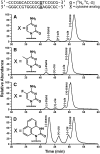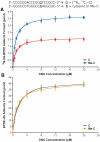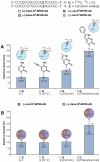Influence of C-5 substituted cytosine and related nucleoside analogs on the formation of benzo[a]pyrene diol epoxide-dG adducts at CG base pairs of DNA
- PMID: 21245046
- PMCID: PMC3089471
- DOI: 10.1093/nar/gkq1341
Influence of C-5 substituted cytosine and related nucleoside analogs on the formation of benzo[a]pyrene diol epoxide-dG adducts at CG base pairs of DNA
Abstract
Endogenous 5-methylcytosine ((Me)C) residues are found at all CG dinucleotides of the p53 tumor suppressor gene, including the mutational 'hotspots' for smoking induced lung cancer. (Me)C enhances the reactivity of its base paired guanine towards carcinogenic diolepoxide metabolites of polycyclic aromatic hydrocarbons (PAH) present in cigarette smoke. In the present study, the structural basis for these effects was investigated using a series of unnatural nucleoside analogs and a representative PAH diolepoxide, benzo[a]pyrene diolepoxide (BPDE). Synthetic DNA duplexes derived from a frequently mutated region of the p53 gene (5'-CCCGGCACCC GC[(15)N(3),(13)C(1)-G]TCCGCG-3', + strand) were prepared containing [(15)N(3), (13)C(1)]-guanine opposite unsubstituted cytosine, (Me)C, abasic site, or unnatural nucleobase analogs. Following BPDE treatment and hydrolysis of the modified DNA to 2'-deoxynucleosides, N(2)-BPDE-dG adducts formed at the [(15)N(3), (13)C(1)]-labeled guanine and elsewhere in the sequence were quantified by mass spectrometry. We found that C-5 alkylcytosines and related structural analogs specifically enhance the reactivity of the base paired guanine towards BPDE and modify the diastereomeric composition of N(2)-BPDE-dG adducts. Fluorescence and molecular docking studies revealed that 5-alkylcytosines and unnatural nucleobase analogs with extended aromatic systems facilitate the formation of intercalative BPDE-DNA complexes, placing BPDE in a favorable orientation for nucleophilic attack by the N(2) position of guanine.
© The Author(s) 2011. Published by Oxford University Press.
Figures











Similar articles
-
Formation of diastereomeric benzo[a]pyrene diol epoxide-guanine adducts in p53 gene-derived DNA sequences.Chem Res Toxicol. 2004 Jun;17(6):731-41. doi: 10.1021/tx049974l. Chem Res Toxicol. 2004. PMID: 15206894
-
Endogenous cytosine methylation and the formation of carcinogen carcinogen-DNA adducts.Nucleic Acids Symp Ser (Oxf). 2008;(52):49-50. doi: 10.1093/nass/nrn025. Nucleic Acids Symp Ser (Oxf). 2008. PMID: 18776247
-
Formation of benzo[a]pyrene diol epoxide-DNA adducts at specific guanines within K-ras and p53 gene sequences: stable isotope-labeling mass spectrometry approach.Biochemistry. 2002 Jul 30;41(30):9535-44. doi: 10.1021/bi025540i. Biochemistry. 2002. PMID: 12135376
-
Conformational changes of a benzo[a]pyrene diol epoxide-N(2)-dG adduct induced by a 5'-flanking 5-methyl-substituted cytosine in a (Me)CG double-stranded oligonucleotide sequence context.Chem Res Toxicol. 2002 Mar;15(3):438-44. doi: 10.1021/tx015588h. Chem Res Toxicol. 2002. PMID: 11896693
-
The influence of cytosine methylation on the chemoselectivity of benzo[a]pyrene diol epoxide-oligonucleotide adducts determined using nanoLC/MS/MS.J Mass Spectrom. 2009 Aug;44(8):1241-8. doi: 10.1002/jms.1605. J Mass Spectrom. 2009. PMID: 19536795 Free PMC article.
Cited by
-
Mapping structurally defined guanine oxidation products along DNA duplexes: influence of local sequence context and endogenous cytosine methylation.J Am Chem Soc. 2014 Mar 19;136(11):4223-35. doi: 10.1021/ja411636j. Epub 2014 Mar 10. J Am Chem Soc. 2014. PMID: 24571128 Free PMC article.
-
Direct LC-MS/MS Detection of Guanine Oxidations in Exon 7 of the p53 Tumor Suppressor Gene.Anal Chem. 2017 Dec 5;89(23):12872-12879. doi: 10.1021/acs.analchem.7b03487. Epub 2017 Nov 22. Anal Chem. 2017. PMID: 29116749 Free PMC article.
-
Hydroxyl-radical-induced oxidation of 5-methylcytosine in isolated and cellular DNA.Nucleic Acids Res. 2014 Jun;42(11):7450-60. doi: 10.1093/nar/gku334. Epub 2014 May 22. Nucleic Acids Res. 2014. PMID: 24852253 Free PMC article.
-
The epigenetic landscape shapes smoking-induced mutagenesis by modulating DNA damage susceptibility and repair efficiency.Nucleic Acids Res. 2025 Feb 8;53(4):gkaf048. doi: 10.1093/nar/gkaf048. Nucleic Acids Res. 2025. PMID: 39933696 Free PMC article.
-
Environmental and Life-Style Related Risk Factors for Sinonasal and Nasopharyngeal Malignancies among a Prospective Cohort in Jos, Nigeria.Int J Otolaryngol. 2018 Oct 16;2018:8524861. doi: 10.1155/2018/8524861. eCollection 2018. Int J Otolaryngol. 2018. PMID: 30410543 Free PMC article.
References
-
- Intenational Agency for Research on Cancer (IARC) France: IARC, Lyon; 1983. Polynuclear aromatic compounds, part I, chemical, environmental, and experimental data. In: IARC Monographs on the Evaluation of the Carcinogenic Risk of Chemicals to Humans; pp. 33–451. - PubMed
-
- Pfeifer GP, Denissenko MF, Olivier M, Tretyakova N, Hecht SS, Hainaut P. Tobacco smoke carcinogens, DNA damage and p53 mutations in smoking-associated cancers. Oncogene. 2002;21:7435–7451. - PubMed
-
- Yang SK, Roller PP, Gelboin HV. Enzymatic mechanism of benzo[a]pyrene conversion to phenols and diols and an improved high-pressure liquid chromatographic separation of benzo[a]pyrene derivatives. Biochemistry. 1977;16:3680–3687. - PubMed
-
- Mazerska Z. Metabolism of chemical carcinogens. In: Baer-Dubowska W, Bartoszek A, Malejka-Giganti D, editors. Carcinogenic and Anticarcinogenic Food Components. Boca Raton, FL: CRC Press; 2006. pp. 37–67.
Publication types
MeSH terms
Substances
Grants and funding
LinkOut - more resources
Full Text Sources
Research Materials
Miscellaneous

